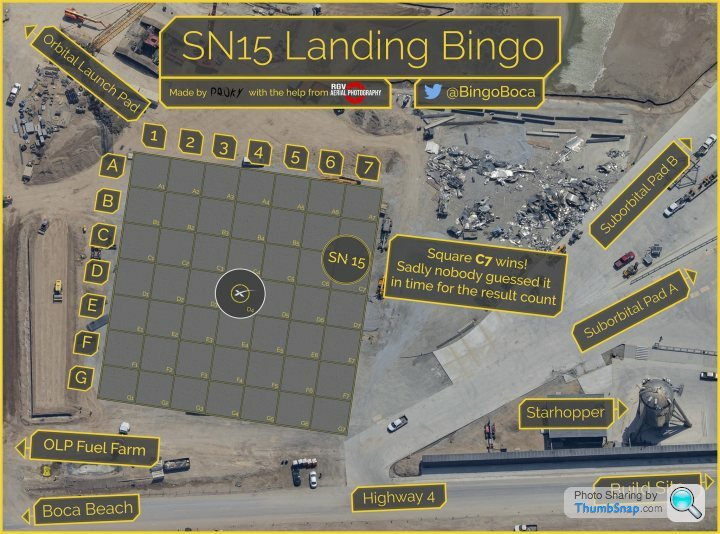SpaceX Tuesday...
Discussion
Getting a booster stage into orbit in one go has been done quite a few times. In the very early days, the sustainer core section of the original Atlas often made it into orbit. Only last week, the core stage of the recent Long March 5 launch made it into orbit - but is due to fall back and burn up in a a couple of days time.
F20CN16 said:
Without vacuum nozzles? Wow.
From Elon's twitter -- https://twitter.com/elonmusk/status/10766135550912...He's talking about Starship here, not the superheavy booster.
CraigyMc said:
From Elon's twitter -- https://twitter.com/elonmusk/status/10766135550912...
He's talking about Starship here, not the superheavy booster.
Ah so it can, but once there it has no purpose.He's talking about Starship here, not the superheavy booster.
Eric Mc said:
Can a Starship achieve orbit on its own? I thought it needed to be bolted to the much more powerful 1st stage (the Super Heavy).

As a minimum it would probably need 3 more atmospheric engines, and that they can run the vacuum engines in atmosphere (like the shuttle).
Depending on the exact fuel consumption (which we don't have figures), it's borderline.
With a payload of ~10-12t it may be feasible. Maybe a smaller payload and a expendable 2nd stage would reduce the risk.
Landing would be tricky, with virtually no margin.
With the information we have, it's plausible, but risky.
SpaceX obviously have more detail, so I would be inclined to trust their assessment.
garyhun said:
rxe said:
In the space of a fortnight, they’ve launched crew to the ISS, they’ve brought back crew from the ISS, they’ve launched 60 satellites, and flown a Starship. That’s a better cadence that all of the worlds space agencies combined. Amazing.
Incredible what they’ve achieved.It an amazing pace for sure.
F20CN16 said:
CraigyMc said:
From Elon's twitter -- https://twitter.com/elonmusk/status/10766135550912...
He's talking about Starship here, not the superheavy booster.
Ah so it can, but once there it has no purpose.He's talking about Starship here, not the superheavy booster.
- nod*
I suppose for testing of things like reentry tiles it could be pretty helpful to try it, but in production use, there's no point in it unless you're trying to get an empty booster into LEO to act as an empty fuel tank that something else will fill.
You can, in theory, make use of an empty fuel tank stage that has made it into orbit.
That was one of the options for Skylab. Launch an SIV stage into orbit - use up all its fuel and then kit the empty fuel tank as a living space. That was known as the "Wet Workshop" model.
This would have been launched on top of a Saturn IB
The alternative was to kit the tank out on earth and launch it ready made for habitation. That was the "Dry Workshop" model. This needed a Saturn V to get into orbit.
They went with the latter - which meant the cancellation of Apollo 18 as the last Saturn V had to be allocated to Skylab.
That was one of the options for Skylab. Launch an SIV stage into orbit - use up all its fuel and then kit the empty fuel tank as a living space. That was known as the "Wet Workshop" model.
This would have been launched on top of a Saturn IB
The alternative was to kit the tank out on earth and launch it ready made for habitation. That was the "Dry Workshop" model. This needed a Saturn V to get into orbit.
They went with the latter - which meant the cancellation of Apollo 18 as the last Saturn V had to be allocated to Skylab.
Eric Mc said:
Getting a booster stage into orbit in one go has been done quite a few times. In the very early days, the sustainer core section of the original Atlas often made it into orbit. Only last week, the core stage of the recent Long March 5 launch made it into orbit - but is due to fall back and burn up in a a couple of days time.
Basically all old rockets work that way, when they were being developed time was of the essence and starting the second stage after staging (air starting) had never been demonstrated. For a booster engine you can test on the ground and do static fires, you can also abort and hold down if it fails to generate enough thrust, for a second stage engine you have to expend a booster and second stage. As a result the early designers expected that developing a second stage that lights in the air may add years to a rocket's development program.Hence the first generation rockets Atlas and the R7 both employed parallel staging where the second stage burns from the ground to orbit. This is slightly less efficient as that second stage cannot have a large expansion ratio on the engine bell and you carry a much larger fuel tank to orbit.
The R7 tank that went to orbit with Sputnik was 28m long and it was this that people on the ground were able to see. That core stage weighed around 6-7 tonnes compared to the payload of ~1 tonne that went to orbit. Hence they put a proper second stage on it by 1960, though they didn't trust it to start after staging so simply started it while the first stage was attached, this is why Soviet rockets have latticework interstates. The second stage meant that the payload went up to 4 tonnes.
Atlas did a "stage and half" staging to get to orbit, this meant that it took off with 3 engines running and then as the fuel burned off the outer two engines were jettisoned. The core stage was thus taken all the way to orbit, it was about 3.5 tonnes vs around 1 tonne of Mercury Capsule. With modern engines an Atlas would have no problem getting a useful payload to orbit as an SSTO. However once they put a second stage (centuar) payload went up to about 4 tonnes and allowed it to send probes to interplanetary locations.
Eric Mc said:
Ian974 said:
This is a bit why I'm hopeful that SN15 or an upcoming prototype will land successfully.
If it was a "traditional" style launch with no aim for the launch vehicle to land again, it'd probably already have been fired towards the horizon over the ocean and likely viewed as going swimmingly.
That test will most likely never be carried out by a Starship as it is not intended to do that. It is the top stage of a much larger rocket. It won't be going anywhere very far, fast or high until it is being tested as part of the full "stack".If it was a "traditional" style launch with no aim for the launch vehicle to land again, it'd probably already have been fired towards the horizon over the ocean and likely viewed as going swimmingly.
Talksteer said:
Starship in theory has around 8000m/s of delta V, it could very nearly get into orbit though it lack the thrust for a takeoff. I suspect that they will expand the envelope and test heat shields with the Starship alone before they risk a whole stack.
I wonder what they’ll do. The current approach is to start the descent from pretty much 0 mph, and they never exceed terminal velocity in the whole descent. You could fly to 15 or 20 km and you’d have essentially the same test - start from zero, terminal all the way down. Could they flip the rocket and power it towards the ground? To get sufficient speed to do do any sort of re-entry testing, you’re going to to need to do some serious lateral movement. To do that without getting into orbit, you’d need to be landing on a barge in the Atlantic, or somewhere in Africa. Landing Starship on a barge would be as cool as hell, and flying over the Atlantic and landing at a precise spot in Africa would be “hard”.
rxe said:
Talksteer said:
Starship in theory has around 8000m/s of delta V, it could very nearly get into orbit though it lack the thrust for a takeoff. I suspect that they will expand the envelope and test heat shields with the Starship alone before they risk a whole stack.
I wonder what they’ll do. The current approach is to start the descent from pretty much 0 mph, and they never exceed terminal velocity in the whole descent. You could fly to 15 or 20 km and you’d have essentially the same test - start from zero, terminal all the way down. Could they flip the rocket and power it towards the ground? To get sufficient speed to do do any sort of re-entry testing, you’re going to to need to do some serious lateral movement. To do that without getting into orbit, you’d need to be landing on a barge in the Atlantic, or somewhere in Africa. Landing Starship on a barge would be as cool as hell, and flying over the Atlantic and landing at a precise spot in Africa would be “hard”.
One of the big cranes (not sure if it's Tankzilla) is rolling out to fetch SN15. I can't quite tell if there's a crawler with it to take it back to the production site. So maybe they're going to stick it back on one of the launch pads!
https://www.youtube.com/watch?v=sTA0GTgFn5E
https://www.youtube.com/watch?v=sTA0GTgFn5E
They probably want to put it back on the stand and remove the engines. I expect they're keen to go over both the rocket and the engines before they decide its future.
It only takes them about an hour per engine to fit them, so they're very much designed to be done in the field like that.
It only takes them about an hour per engine to fit them, so they're very much designed to be done in the field like that.
Beati Dogu said:
They probably want to put it back on the stand and remove the engines. I expect they're keen to go over both the rocket and the engines before they decide its future.
It only takes them about an hour per engine to fit them, so they're very much designed to be done in the field like that.
There was a fire after it landed so I'd imagine they will want to check for damage too. The eventual product is supposed to have a very fast turnaround time (basically similar to the refuelling time) but this test article probably has loads of exposed loom and stuff that may have been destroyed.It only takes them about an hour per engine to fit them, so they're very much designed to be done in the field like that.
Of course I went to bed and then fell asleep before missing this milestone.
Well done SpaceX. The new bits seem to be good, whenever testing new stuff it could go wrong but those pernickety Raptors may have been tamed for descent.

They are still never going to get to Mars but at least they are launching.
I see the poke at Jeff on Twitter by Elon on "getting it up" has finally got Blue Origin to do a manned sub orbital flight.
Well done SpaceX. The new bits seem to be good, whenever testing new stuff it could go wrong but those pernickety Raptors may have been tamed for descent.

They are still never going to get to Mars but at least they are launching.
I see the poke at Jeff on Twitter by Elon on "getting it up" has finally got Blue Origin to do a manned sub orbital flight.
Gassing Station | Science! | Top of Page | What's New | My Stuff






